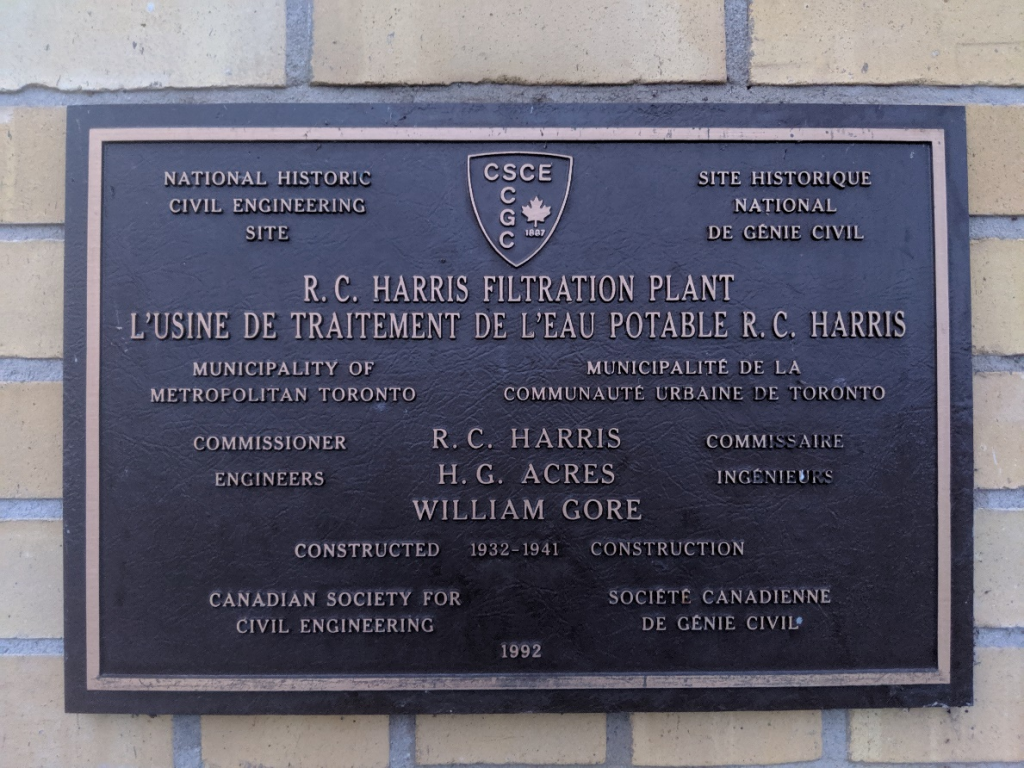
Site Location: Lat.: 43° – 40’ – 24” N; Long.: 79° – 16’ – 24” W. (GPS: 43.6734074, -79.2789182). 2701 Queen St. E., Scarborough, ON. Heading southbound on the Don Valley Parkway, take the Eglinton Avenue East exit. Proceed for 2.5 km on Eglinton Avenue and turn right (south) on Victoria Park Avenue. After 5.9 km, turn left (east) onto Queen Street. The Harris Filtration Plant is on the right 100 m after the turn.
Plaque Location: to right of main entrance, at north façade of building.

Description: The R. C. Harris Water Treatment Plant, which opened in 1941, is Toronto’s largest treatment facility, with a capacity of almost 100 million cubic metres per day. It is named after Roland Caldwell Harris, Commissioner of Works for the City of Toronto from 1912 until his death in 1945. City Council retained consulting engineers H.G. Acres and William Gore to start design of the plant in 1926 and constriction started in 1932. Due to Harris’ and his consultants’ foresight, plenty of space was left for the plant’s expansion which took place between 1955-1958 at a cost of $7.3 million.
Historic Significance: The signature projects of R.C. Harris are the Prince Edward Viaduct crossing the Don River, and the R. C. Harris Filtration Plant, both CSCE National Historic Sites. Architect Thomas C. Pomphrey was responsible for the building design in the classical Beaux Arts style. The stunning interior finishes and the immaculate lawns surrounding the plant make it, as it has been called, A Palace of Purification”.
Henry G. Acres was born in Paris, Ontario in 1880 and graduated from the University of Toronto in Mechanical and Electrical Engineering. He became one of the first employees of the newly established Ontario Hydro, was made Chief Hydraulic Engineer in 1911 and was put in charge of power development at Niagara Falls. In 1924, Acres established his own consulting firm, specializing in electric power generation and municipal engineering. Coincidently, both Harris and Acres died in September, 1945.
William Gore was educated as an engineer and practiced engineering in Great Britain for a number of years, before coming to Canada in 1913, forming a partnership with George Nasmith and William Storrie which lasted until his death in 1934. Gore specialized in the design and construction of water supply installations and sewage disposal plants.

Plaque wording: National Historic Civil Engineering Site. CSCE. R. C. HARRIS FILTRATION PLANT. Municipality of Metropolitan Toronto. Commissioner R. C. Harris. Engineers H. G. Acres William Gore. Constructed 1932-1941. Canadian Society for Civil Engineering. 1992.
SCGC. Site Historique National de Génie Civil. L’USINE DE TRAITEMENT DE L’EAU POTABLE R. C. HARRIS. Municipalité de la communauté de Toronto. R. C. Harris Commissaire. H. G. Acres William Gore Ingénieurs. Société canadienne de genie civil. 1992.
Links to Online Documentation:
“The R. C. Harris Project”, the rcharrisproject.blogspot.com.
Steven Mannell, “Water Works”, Canadian Architect, 2002.
“R. C. Harris Plant celebrates its history”, Canadian Consulting Engineer, 2002.